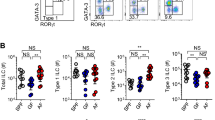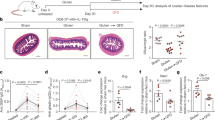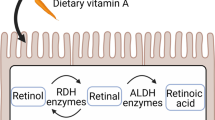Abstract
Under physiological conditions the gut-associated lymphoid tissues not only prevent the induction of a local inflammatory immune response, but also induce systemic tolerance to fed antigens1,2. A notable exception is coeliac disease, where genetically susceptible individuals expressing human leukocyte antigen (HLA) HLA-DQ2 or HLA-DQ8 molecules develop inflammatory T-cell and antibody responses against dietary gluten, a protein present in wheat3. The mechanisms underlying this dysregulated mucosal immune response to a soluble antigen have not been identified. Retinoic acid, a metabolite of vitamin A, has been shown to have a critical role in the induction of intestinal regulatory responses4,5,6. Here we find in mice that in conjunction with IL-15, a cytokine greatly upregulated in the gut of coeliac disease patients3,7, retinoic acid rapidly activates dendritic cells to induce JNK (also known as MAPK8) phosphorylation and release the proinflammatory cytokines IL-12p70 and IL-23. As a result, in a stressed intestinal environment, retinoic acid acted as an adjuvant that promoted rather than prevented inflammatory cellular and humoral responses to fed antigen. Altogether, these findings reveal an unexpected role for retinoic acid and IL-15 in the abrogation of tolerance to dietary antigens.
This is a preview of subscription content, access via your institution
Access options
Subscribe to this journal
Receive 51 print issues and online access
$199.00 per year
only $3.90 per issue
Buy this article
- Purchase on Springer Link
- Instant access to full article PDF
Prices may be subject to local taxes which are calculated during checkout




Similar content being viewed by others
References
Curotto de Lafaille, M. A. & Lafaille, J. J. Natural and adaptive Foxp3+ regulatory T cells: more of the same or a division of labor? Immunity 30, 626–635 (2009)
Faria, A. M. & Weiner, H. L. Oral tolerance. Immunol. Rev. 206, 232–259 (2005)
Jabri, B. & Sollid, L. M. Tissue-mediated control of immunopathology in coeliac disease. Nature Rev. Immunol. 9, 858–870 (2009)
Coombes, J. L. et al. A functionally specialized population of mucosal CD103+ DCs induces Foxp3+ regulatory T cells via a TGF-β and retinoic acid-dependent mechanism. J. Exp. Med. 204, 1757–1764 (2007)
Mora, J. R., Iwata, M. & von Andrian, U. H. Vitamin effects on the immune system: vitamins A and D take centre stage. Nature Rev. Immunol. 8, 685–698 (2008)
Mucida, D. et al. Reciprocal TH17 and regulatory T cell differentiation mediated by retinoic acid. Science 317, 256–260 (2007)
Mention, J. J. et al. Interleukin 15: a key to disrupted intraepithelial lymphocyte homeostasis and lymphomagenesis in celiac disease. Gastroenterology 125, 730–745 (2003)
Tagaya, Y., Bamford, R. N., DeFilippis, A. P. & Waldmann, T. A. IL-15: a pleiotropic cytokine with diverse receptor/signaling pathways whose expression is controlled at multiple levels. Immunity 4, 329–336 (1996)
Fehniger, T. A. et al. Fatal leukemia in interleukin-15 transgenic mice follows early expansions in natural killer and memory phenotype CD8+ T cells. J. Exp. Med. 193, 219–232 (2001)
Caretto, D. et al. Cutting edge: the Th1 response inhibits the generation of peripheral regulatory T cells. J. Immunol. 184, 30–34 (2010)
Yokoyama, S. et al. Antibody-mediated blockade of IL-15 reverses the autoimmune intestinal damage in transgenic mice that overexpress IL-15 in enterocytes. Proc. Natl Acad. Sci. USA 106, 15849–15854 (2009)
Bettelli, E. et al. Reciprocal developmental pathways for the generation of pathogenic effector TH17 and regulatory T cells. Nature 441, 235–238 (2006)
Gao, Y., Camacho, L. H. & Mehta, K. Retinoic acid-induced CD38 antigen promotes leukemia cells attachment and interferon-γ/interleukin-1β-dependent apoptosis of endothelial cells: implications in the etiology of retinoic acid syndrome. Leuk. Res. 31, 455–463 (2007)
Mohty, M. et al. All-trans retinoic acid skews monocyte differentiation into interleukin-12-secreting dendritic-like cells. Br. J. Haematol. 122, 829–836 (2003)
Rochette-Egly, C. & Germain, P. Dynamic and combinatorial control of gene expression by nuclear retinoic acid receptors (RARs). Nucl. Recept. Signal. 7, e005 (2009)
Mazzarella, G. et al. Gliadin activates HLA class I-restricted CD8+ T cells in celiac disease intestinal mucosa and induces the enterocyte apoptosis. Gastroenterology 134, 1017–1027 (2008)
Nilsen, E. M. et al. Gluten specific, HLA-DQ restricted T cells from coeliac mucosa produce cytokines with Th1 or Th0 profile dominated by interferon gamma. Gut 37, 766–776 (1995)
Dieterich, W. et al. Identification of tissue transglutaminase as the autoantigen of celiac disease. Nature Med. 3, 797–801 (1997)
Black, K. E., Murray, J. A. & David, C. S. HLA-DQ determines the response to exogenous wheat proteins: a model of gluten sensitivity in transgenic knockout mice. J. Immunol. 169, 5595–5600 (2002)
Marsh, M. N. Gluten, major histocompatibility complex, and the small intestine. A molecular and immunobiologic approach to the spectrum of gluten sensitivity (‘celiac sprue’). Gastroenterology 102, 330–354 (1992)
Meresse, B. et al. Coordinated induction by IL15 of a TCR-independent NKG2D signaling pathway converts CTL into lymphokine-activated killer cells in celiac disease. Immunity 21, 357–366 (2004)
Monteleone, I. et al. Characterization of IL-17A-producing cells in celiac disease mucosa. J. Immunol. 184, 2211–2218 (2010)
Bodd, M. et al. HLA-DQ2-restricted gluten-reactive T cells produce IL-21 but not IL-17 or IL-22. Mucosal Immunol. 3, 594–601 (2010)
Hunt, K. A. et al. Newly identified genetic risk variants for celiac disease related to the immune response. Nature Genet. 40, 395–402 (2008)
Reddy, D., Siegel, C. A., Sands, B. E. & Kane, S. Possible association between isotretinoin and inflammatory bowel disease. Am. J. Gastroenterol. 101, 1569–1573 (2006)
Stephensen, C. B. & Livingston, K. A. Vitamin supplements and vaccines: maximize benefits, evaluate potential risks. Am. J. Clin. Nutr. 90, 457–458 (2009)
Holmgren, J. & Czerkinsky, C. Mucosal immunity and vaccines. Nature Med. 11 (suppl.). S45–S53 (2005)
Kraus, T. A. et al. Failure to induce oral tolerance to a soluble protein in patients with inflammatory bowel disease. Gastroenterology 126, 1771–1778 (2004)
Liu, Z. et al. IL-15 is highly expressed in inflammatory bowel disease and regulates local T cell-dependent cytokine production. J. Immunol. 164, 3608–3615 (2000)
Hill, J. A. et al. Retinoic acid enhances Foxp3 induction indirectly by relieving inhibition from CD4+CD44hi Cells. Immunity 29, 758–770 (2008)
Fontenot, J. D. et al. Regulatory T cell lineage specification by the forkhead transcription factor Foxp3. Immunity 22, 329–341 (2005)
Veldhoen, M. et al. TGFβ in the context of an inflammatory cytokine milieu supports de novo differentiation of IL-17-producing T cells. Immunity 24, 179–189 (2006)
Depaolo, R. W. et al. Toll-like receptor 6 drives differentiation of tolerogenic dendritic cells and contributes to LcrV-mediated plague pathogenesis. Cell Host Microbe 4, 350–361 (2008)
Hill, J. A. et al. Retinoic acid enhances Foxp3 induction indirectly by relieving inhibition from CD4+CD44hi cells. Immunity 29, 758–770 (2008)
Park, S. H. et al. Selection and expansion of CD8α/α1 T cell receptor α/β1 intestinal intraepithelial lymphocytes in the absence of both classical major histocompatibility complex class I and nonclassical CD1 molecules. J. Exp. Med. 190, 885–890 (1999)
Lefrancois, L. & Lycke, N. Isolation of mouse small intestinal intraepithelial lymphocytes, Peyer’s patch, and lamina propria cells. Curr. Protoc. Immunol. 10.1002/0471142735.im0319s17 (2001)
Bernardin, J. E., Kasarda, D. D. & Mecham, D. K. Preparation and characterization of α-gliadin. J. Biol. Chem. 242, 445–450 (1967)
Marietta, E. et al. A new model for dermatitis herpetiformis that uses HLA-DQ8 transgenic NOD mice. J. Clin. Invest. 114, 1090–1097 (2004)
Acknowledgements
We thank coeliac disease patients and their family members as well as the University of Chicago Celiac Disease Center for supporting our research. We thank B. Sally, L. M. Sollid and M. Musch for critical reading of the manuscript. We thank C. Ciszewski, B. Uzunparmak, and N. Grandison for their help with the collection and analysis of human biopsies. We thank M. Constantinides for technical assistance with mice breeding. We also thank the University of Chicago flow cytometry facility for technical assistance. Dd-IL-15 transgenic mice were a gift from M. Caligiuri. RARα-deficient mice were provided by P. Chambon and C. Benoist. This work was supported by the Digestive Disease Research Core Center at the University of Chicago (DK42086), R01 DK67180 (for B.J.), R01DK71003 (for J.A.M.), and the Crohn’s and Colitis Foundation (for V.A.).
Author information
Authors and Affiliations
Contributions
R.W.D. and V.A. provided input into the conceptual development and execution of the studies, as well as preparation of the manuscript. F.T., H.F.-P., J.A.H. and W.W. provided technical assistance and input into data analyses. J.A.M. and E.V.M. helped with the analysis of the humanized HLA-DQ8 transgenic mice. D.D.K. provided preparations of α-gliadin used in the feeding experiments, T.A.W. provided TMβ-1 antibody, and Y.B. helped with the realization of T-cell transfer experiments and provided us with RARα-deficient bone-marrow. C.S., S.K. and S.G. followed patients with coeliac disease and provided intestinal biopsies for cytokines analysis. Y.B., J.A.M., D.D.K. and T.A.W. participated in discussion and review of the manuscript. B.J. conceived the idea, wrote the manuscript and supervised all investigations.
Corresponding author
Ethics declarations
Competing interests
The authors declare no competing financial interests.
Supplementary information
Supplementary Figures
The file contains Supplementary Figures 1-11 with legends. (PDF 775 kb)
Rights and permissions
About this article
Cite this article
DePaolo, R., Abadie, V., Tang, F. et al. Co-adjuvant effects of retinoic acid and IL-15 induce inflammatory immunity to dietary antigens. Nature 471, 220–224 (2011). https://doi.org/10.1038/nature09849
Received:
Accepted:
Published:
Issue Date:
DOI: https://doi.org/10.1038/nature09849
This article is cited by
-
Cellular and micro-environmental responses influencing the antitumor activity of all-trans retinoic acid in breast cancer
Cell Communication and Signaling (2024)
-
Novel Drug Therapeutics in Celiac Disease: A Pipeline Review
Drugs (2022)
-
Retinoic acid signaling acts as a rheostat to balance Treg function
Cellular & Molecular Immunology (2022)
-
“World in motion” – emulsion adjuvants rising to meet the pandemic challenges
npj Vaccines (2021)
-
The expression levels of CHI3L1 and IL15Rα correlate with TGM2 in duodenum biopsies of patients with celiac disease
Inflammation Research (2020)
Comments
By submitting a comment you agree to abide by our Terms and Community Guidelines. If you find something abusive or that does not comply with our terms or guidelines please flag it as inappropriate.



